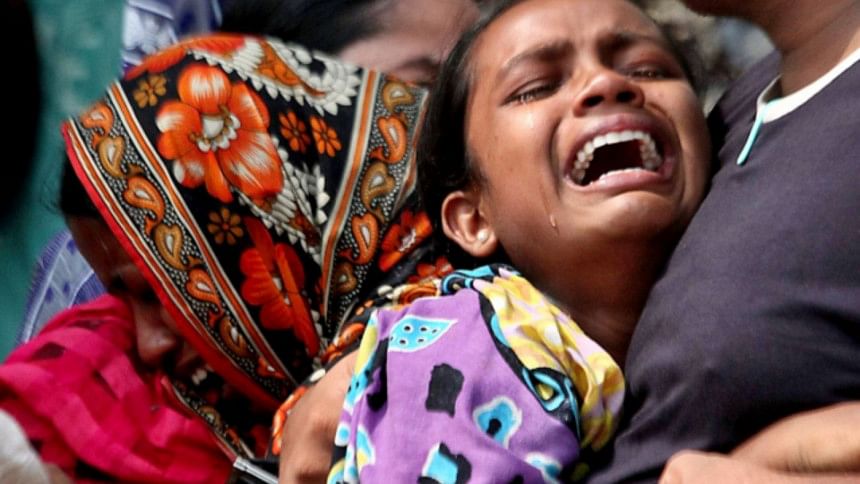Post-Rana Plaza initiatives and sustainability of the RMG sector

THE tragedy that took place on April 24, 2013 in a suburb of Bangladesh, a few miles away from the capital, became a global tragedy. Though unsafe working condition is a problem in several low income and developing countries, the Rana Plaza disaster received worldwide coverage not only because of the enormity of the casualty, but also due to its global linkages. Rana Plaza, where five readymade garments factories were housed which supplied clothes to many brands and retailers in Europe and North America, drew global attention as interests of both domestic and international stakeholders were stitched in the same thread. The factory owners, the government, buyers, workers and consumers – they are all part of the value chain of this industry and have a claim on it.
Two years on, the RMG industry has experienced several positive changes, though ironically, at the cost of more than 1100 lives and about 2400 wounded souls and bodies. Following the incident, the labour law of the country has been amended and the right to form trade unions in the factory has been approved. The minimum wage of workers was raised to Tk. 5,300 in November 2013 from Tk. 3,000 set in 2010 in an attempt to make it comparable to other competing countries and to allow a decent life to workers.
The National Tripartite Plan of Action on Fire, Electrical Safety and Physical Integrity (NAP) in the readymade garment sector of Bangladesh has been set up by the government and facilitated by International Labour Organisation to undertake safety related activities. Other initiatives such as Alliance by buyers and retailers of North American countries and the Bangladesh Accord comprising several global brands and retailers of the European Union markets have also been working on fire and building and workers' safety.
More specifically, Alliance has been undertaking inspection in all 700 factories from where its members buy their garments while the Accord has been inspecting all 1619 factories from where EU buyers source their clothes. NAP is also conducting inspection of about 1300 factories. In all cases, the number of risky and vulnerable factories has so far been small. On the other hand, BGMEA has also been doing its part by arranging training programmes on worker-management relations and labour laws for both factory management and workers.
These initiatives involve expenditures, but they are in fact the benefits in medium and long terms as they will contribute to improve the sector and make it sustainable. Such investments were necessary for the industry to maintain its growth. These are investments for future that will yield returns through higher exports, employment and growth. As Bangladesh eyes at earning $50 billion through RMG exports by 2021, the sector needs to upgrade itself by undertaking such reforms.
The cost of the Rana Plaza tragedy is, however, insurmountable. The lives that were lost, the wounded workers who are unable to work, the families which have to spend on medication of the injured and the children who are deprived of education - all these involve high cost. No amount of money can really compensate for such losses. As economists we try to quantify everything and express them in monetary terms. We also estimate the value of life – of course purely in statistical sense. However, emotions, feelings, pain, discomfort, mental agony and the like cannot be measured. If the statistical value of lives of the Rana Plaza victims are calculated the numbers will be humongous and beyond our imagination.
Therefore, funds to cover loss of income and medical expenses from various sources are only a small fraction of the actual amount of losses. ILO has come up with a compensation figure of $30 million and initiated Rana Plaza Donors Trust Fund. Clearly, this is an underestimation. Of course, it is commendable that resources for compensating the victims have been committed from various sources including the government, RMG manufacturers, buyers and donors. However, international brands have not provided adequate fund to fill up the pot of the Donors Trust Fund.
While the initiatives during the aftermath of Rana Plaza have been promising, it is time to think about the sustainability of these programmes and their outcomes. How long will Accord, Alliance and others continue to work on buildings and workers' safety? Are the government agencies ready to take responsibility for such disasters in future? Will the spirit of the industry leaders continue to be upheld in the same manner in the coming days? What will be the commitment of global brands toward ethical buying? Can the workers take the opportunity to organise themselves and articulate their demands through better negotiation skills both at home and globally? And finally and most importantly, will these initiatives make any substantive positive change in the lives of workers? These are some pertinent questions that need to be addressed on the eve of the second anniversary of the gruesome Rana Plaza incident.
The writer is Research Director at CPD, currently a Visiting Scholar at the Earth Institute, Columbia University, New York.

 For all latest news, follow The Daily Star's Google News channel.
For all latest news, follow The Daily Star's Google News channel. 



Comments